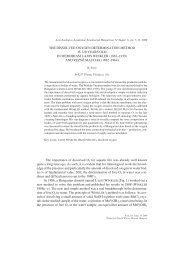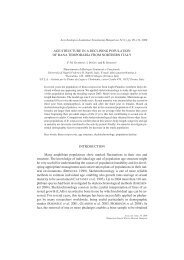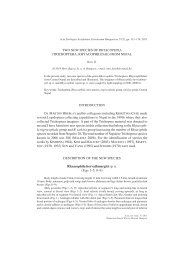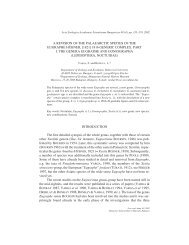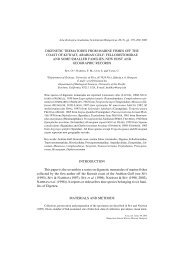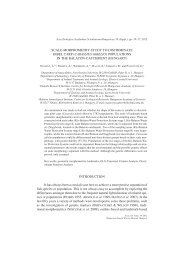AN EVALUATION OF STONE MARTEN (MARTES ... - ResearchGate
AN EVALUATION OF STONE MARTEN (MARTES ... - ResearchGate
AN EVALUATION OF STONE MARTEN (MARTES ... - ResearchGate
Create successful ePaper yourself
Turn your PDF publications into a flip-book with our unique Google optimized e-Paper software.
Acta Zoologica Academiae Scientiarum Hungaricae 55 (2), pp. 199–209, 2009<br />
<strong>AN</strong> <strong>EVALUATION</strong> <strong>OF</strong> <strong>STONE</strong> <strong>MARTEN</strong> (<strong>MARTES</strong> FOINA)<br />
RECORDS IN THE CITY <strong>OF</strong> BUDAPEST, HUNGARY<br />
TÓTH, M. 1 , BÁRÁNY, A. 2 and KIS, R. 3<br />
1 Department of Systematic Zoology and Ecology, Eötvös Loránd University<br />
1117 Budapest, Pázmány Péter s. 1/c, Hungary, E-mail: toth.maria@gmail.com<br />
2 Hungarian National Museum, 1088 Budapest, Múzeum körút 14–16, Hungary<br />
3 DHISTECH Kft., 1121 Budapest, Konkoly-Thege út 29–33, Hungary<br />
A multi-scale investigation into the urbanization process of the stone marten in Budapest was<br />
initiated in 1996. Topographic records (n = 214) of stone martens were gathered within the<br />
city’s administrative area (525 km 2 ) on the basis of questionnaires, correspondence and<br />
phone-calls. Earlier studies had pointed out that the occurrence and the diversity of the<br />
food-basis of this species does not show a significant relation to the greenness of habitats in<br />
Budapest. The aim of our analysis was to search for connections between confirmed records of<br />
stone martens and the habitat and structure of patches where they were located. Two main<br />
types of patches were defined: green habitat had >50% green covering, desert habitat ≤ 50%.<br />
Overall, the green patches were preferred (67%), although certain desert patches had a relatively<br />
high density of sightings. The reason for this might come from compensating factors,<br />
such as the structure of buildings, the type of roof or gutter. The multi-storey, old and often neglected<br />
houses, sometimes with inner gardens, appear to be excellent hideouts that also provide<br />
some nutritive sources. No similar analysis appears to have been carried out to date neither<br />
in Budapest nor elsewhere.<br />
Key words: building, Budapest, occurrence, stone marten, urban<br />
INTRODUCTION<br />
The urbanisation of animals has shown an accelerating tendency in recent<br />
years both in the number of species and the expansion of their habitats. Cities are<br />
the most densely urbanized human settlements. They often have variable structure<br />
and history and may provide a variety of resources, such as food, shelter and migration<br />
corridors for various species. Through historical times, the growing cities<br />
encroached upon or surrounded adjacent natural habitats. While the impact of urbanization<br />
on the surrounding landscape has been widely studied, a lot less is usually<br />
known about the animals that inhabit cities.<br />
The stone marten’s colonization of urban habitats started in the 1950’s in most<br />
of the Central and Western Continental European countries (BISSONETTE &BROEK-<br />
HUIZEN 1995). This process cannot be attributed to diminishing natural habitats.<br />
Rather, the stone marten’s successful urban settlement and integration into the urban<br />
food web is attributed to its flexibility: they are known to be dietary opportun-<br />
Acta zool. hung. 55, 2009<br />
Hungarian Natural History Museum, Budapest
200 TÓTH, M., BÁRÁNY, A. & KIS, R.<br />
ists, generalists and fairly skilled predators (GENOVESI &BOIT<strong>AN</strong>I 1997, L<strong>AN</strong>SZKI<br />
2003, TÓTH 2003). Their body shape and size enables them to move briskly across<br />
all terrains. Urban stone martens live practically side by side with humans, using<br />
attics, roofs and suspended ceilings as den-sites (TÓTH &SZENCZI 2004, HERR et<br />
al. 2009b). Their ingenuity seems to be limitless: they create holes between tiles,<br />
use guttering and plumbing, climb on lightning conductors, use staircases to access<br />
well insulated safe attics, roofing, thatched roofs, neglected rooms, suspended ceilings,<br />
or church towers, etc. (TÓTH &SZENCZI 2004). Other factors contributing to<br />
their success may be the absence of larger predators and a low density of competitors<br />
(V<strong>AN</strong> DRUFF et al. 1996). At the same time, they might cause significant financial<br />
and sanitary problems (TÓTH et al. 2007a,SZŐCS et al. 2008, HERR 2008). Unlike<br />
other countries, where stone martens have been known to enter and damage<br />
cars since the late 1970s (reviewed in HERR 2008), this is knew phenomenon in<br />
Hungary.<br />
In Hungary, the stone marten is currently a widespread and common carnivore.<br />
Consequently, its status was changed from protected to hunted game in 1996<br />
(SZEMETHY &HELTAI 1996, TÓTH et al. 2007b). It is also frequent in urban environments.<br />
There have been some studies indicating the generalist, opportunistic features<br />
and the high degree of adaptability of the stone marten in Budapest (TÓTH 1998,<br />
TÓTH 2003, SZENCZI 2005, BÁRÁNY 2006). They demonstrated a high diversity<br />
and seasonal changes of food composition. This diversity did not correlate with the<br />
greenness of habitats and the stone martens appeared to prefer the patchy but dense<br />
food sources (TÓTH & SZENCZI 2004, TÓTH et al. 2007).<br />
However, it is still not well understood what exactly makes highly disturbed<br />
urban areas attractive for stone martens. In addition to food, the cover effect is believed<br />
to constitute an important factor. Thus the structural characteristics of old<br />
buildings may facilitate the stone marten’s (and probably other urban vertebrates’)<br />
colonisation of the inner districts of Budapest. The data was collected through visiting<br />
a wide range of buildings.<br />
The question is how these ecological factors (i.e. food availability, green<br />
spaces, cover) rank in terms of priority. The aims of our analysis were to use data<br />
from a 13-year monitoring program of stone marten presence in Budapest 1) to<br />
map the extent of its occurrence through the city; 2) to test the quality (in terms of<br />
greenness) of the habitat patches visited by martens; 3) to highlight characteristics<br />
of used patches and define the preferred type of buildings.<br />
Acta zool. hung. 55, 2009
<strong>AN</strong> <strong>EVALUATION</strong> <strong>OF</strong> <strong>STONE</strong> <strong>MARTEN</strong> (<strong>MARTES</strong> FOINA) RECORDS IN BUDAPEST, HUNGARY 201<br />
METHODS<br />
Study area<br />
Budapest has an administrative area of 525 km2 consisting of 23 districts (Fig. 1) with a population<br />
of about 1.8 million residents (Hungarian Central Statistical Office 2001). The city is split into<br />
two parts by the Danube river. The Buda side (west of Danube) represents the green part of the city,<br />
occupying the surrounding hills, while Pest (east of Danube) forms a densely developed basin, with a<br />
highly fragmented landscape. Both parts have undergone intensive redevelopment during the last few<br />
years, resulting in significant changes in the structural, sociological and ecological aspects of the city.<br />
Data collection and analysis<br />
Between 1996 and 2008 the presence of stone martens was recorded through field work, phone<br />
calls, email correspondence or a questionnaire that was available through the webpage of our research<br />
group. An attempt was made to confirm all records, other than sightings of living or dead specimens,<br />
through the presence of hair, scats, or footprints.<br />
Fig. 1. Numbering and location of the 23 districts in Budapest. The grey patches represent the<br />
DESERT (≤ 50% green) and the striped patches represent the GREEN (≥ 50% green) type districts<br />
according to the records on the stone marten. There were no topographical data available for districts<br />
6 and 10 until 2008<br />
Acta zool. hung. 55, 2009
202 TÓTH, M., BÁRÁNY, A. & KIS, R.<br />
Table 1. Basic data for the evaluation of stone marten records in Budapest (1996–2008). C: Code of districts, TR: No. of topographic records included<br />
the GIS database (n = 214), AR: No. of all records between 1996–2008 (n = 303), A: Area of the districts (km2 )<br />
C 1 2 3 4 5 6 7 8 9 10 11 12 13 14 15 16 17 18 19 20 21 22 23<br />
TR 6 55 20 5 1 0 4 6 16 0 25 28 11 10 2 1 4 5 3 1 1 9 1<br />
AR 11 65 31 7 2 3 4 7 21 2 34 42 14 17 4 5 4 12 4 3 1 9 1<br />
A 3.4 36.3 39.7 18.8 2.6 2.4 2.1 6.8 12.5 32.5 33.5 26.7 13.4 18.1 26.9 33.5 54.8 38.6 9.4 12.2 25.8 34.3 40.8<br />
Acta zool. hung. 55, 2009<br />
The topographical records were marked on a map using a Geographical<br />
Information System (ArcView GIS 3.2). Following conversion<br />
from WGS-84 to EOV (Standard National Projection Grid of Hungary),<br />
the maximum coordinate error was 0.17 m. The following additional data<br />
was recorded for each report: year of sighting, district code, type of damages<br />
caused by the animals, and presence of progeny. The latest investigations<br />
have indicated that urban stone martens use relatively small home<br />
ranges of between 4 to 122 ha in size (BISSONETTE &BROEKHUIZEN 1995,<br />
ESKREYS-WÓJCIK et al. 2008, HERR et al. 2009a), depending on sex, age<br />
and density. Based on the findings it was decided to use a 25 ha square<br />
(hereafter also referred to as ‘patch’) as a possible, average “urban” home<br />
range (SZENCZI 2005, BÁRÁNY 2006, TÓTH et al. 2007a). The GPS records<br />
of stone martens were marked on a map in Google Earth and overlaid<br />
with a 500 m × 500 m (25 ha) grid. The ratio of the green areas (e.g.,<br />
gardens, parks, cemeteries, sports grounds, etc.) to built-up environment<br />
(buildings, railways, roads, etc.) within a patch was expressed as the ratio<br />
of the different coloured pixels (Adobe Photoshop CS2). Each 25<br />
ha-quadrate was characterised based on the ratio of green areas and the<br />
main type of buildings that were located within it.<br />
Two greenness categories defined as GREEN (> 50%) and<br />
DESERT (≤ 50%) on the basis of the proportion of green pixels. Based on<br />
visual analysis of Google Earth aerial photos on field work, three building<br />
categories were defined: AB = predominantly family houses with gardens;<br />
BB = predominantly multi-storey, old houses with a quadrangle, often<br />
with a circular gallery; CB = all the other built-up environments, such<br />
as modern buildings, panels (blocks of multi-storey houses), roads, railways<br />
and industrial areas.<br />
Due to the data not being normally distributed, the Spearman’s<br />
Rank correlation (Statistica 6.0) was used to assess the correlation between<br />
the density of stone marten records and greenness of patches.<br />
An evaluation was carried out of the completed online questionnaires<br />
(n = 42). Source data for this pilot project included a wide range of<br />
information regarding the stone marten’s occurrence (date, place), habitat,<br />
behaviour, potential food sources, progeny and conflict with human<br />
interest.<br />
RESULTS<br />
Over the course of the 13-year monitoring program,<br />
415 reports of stone marten presence were received. Of<br />
those, 303 topographical records contained all background<br />
data. There was an overall trend for the yearly number of records<br />
increasing over the study period (Fig. 2). Due to the<br />
observers’ request only 214 records were represented as<br />
habitat patches in the GIS database (Table 1). A further 112
ecords presented essential information but lacked exact addresses of sightings.<br />
Thus, only 21 one of the 23 three districts of Budapest were represented in the statistical<br />
analysis, as no topographical records existed for districts 6 and 10. Most of<br />
the 415 observations (approx. 90%) were the result of noise, large amounts of scats<br />
or damaged roof insulation in attics. Only a few records (10%) were actual sightings<br />
of live or dead specimen.<br />
Districts<br />
<strong>AN</strong> <strong>EVALUATION</strong> <strong>OF</strong> <strong>STONE</strong> <strong>MARTEN</strong> (<strong>MARTES</strong> FOINA) RECORDS IN BUDAPEST, HUNGARY 203<br />
The highest numbers of marten reports were recorded for districts 2, 3, 9, 11<br />
and 12 (Table 1).<br />
Density of marten records was calculated for each district on the basis of the<br />
area of the given districts and the number of local records (Fig. 3). The highest density<br />
occurred in the 1st, 2nd, 7th, 9th and 12th districts with more than 1 record<br />
/km 2 . Only the 1st and the 2nd districts belonged to the so called green districts<br />
(Fig. 4), with more parks and family houses with gardens, etc. There was a weak<br />
negative correlation between the greenness of districts and the density of marten<br />
records Spearman’s r s = – 0.43636 (p = 0.048). The results indicated that the density<br />
of stone marten records did not correlate positively with the greenness of<br />
patches (Fig. 5).<br />
100<br />
90<br />
80<br />
70<br />
60<br />
50<br />
40<br />
30<br />
20<br />
10<br />
0<br />
4<br />
8<br />
12<br />
14<br />
19<br />
3<br />
27<br />
16<br />
27<br />
44<br />
18<br />
95<br />
1996<br />
1997<br />
1998<br />
1999<br />
2000<br />
2001<br />
2002<br />
2003<br />
2004<br />
2005<br />
2006<br />
2007<br />
2008<br />
Fig. 2. The number of yearly topographical records of stone martens in Budapest (n = 303) during the<br />
13 years of monitoring<br />
16<br />
Acta zool. hung. 55, 2009
204 TÓTH, M., BÁRÁNY, A. & KIS, R.<br />
Fig. 3. Density of stone marten records (n = 214) in Budapest districts (n = 23) between 1996 and<br />
2008. The black coloured columns represent the districts with at least one or more registrations per km 2<br />
ratio of green pixels<br />
80<br />
70<br />
60<br />
50<br />
40<br />
30<br />
20<br />
10<br />
0<br />
Acta zool. hung. 55, 2009<br />
1 2 3 4 5 6 7 8 9 10 11 12 13 14 15 16 17 18 19 20 21 22 23<br />
Code of districts in Budapest<br />
Fig. 4. Average greenness (%) of those 25 ha patches (n = 225) that contained at least one marten record.<br />
Green (> 50%) districts are highlighted in black
<strong>AN</strong> <strong>EVALUATION</strong> <strong>OF</strong> <strong>STONE</strong> <strong>MARTEN</strong> (<strong>MARTES</strong> FOINA) RECORDS IN BUDAPEST, HUNGARY 205<br />
Habitat patches<br />
Martens appeared to show a preference for GREEN habitats as the majority<br />
(67.7%) of records were located in green type of habitat patches. Nevertheless, in<br />
some cases marten record densities were actually higher in DESERT type habitats<br />
than in the GREEN patches. For example, all records on Üllői street (districts 8 and<br />
9), which is situated in the central part of Pest, a highly built-up, disturbed and<br />
crowded part of Budapest were located in DESERT type patches. Sightings in<br />
these DESERT patches were frequent (up to 10 records / patch), whereas, several<br />
GREEN patches had only one or two records during the long-term observation period.<br />
Stone martens showed a strong preference for old multi- storey buildings<br />
with a quadrangle. There were 69 DESERT patches among the 214 topographical<br />
detections. Thirty-nine of those were identified as having extremely small green<br />
coverage (proportion of green pixels 5–30%), with 30 patches being classed as<br />
multi-storey buildings with quadrangles (BB), 3 as family houses (AB) and 6 as<br />
others (CB).<br />
density<br />
4.0<br />
3.5<br />
3.0<br />
2.5<br />
2.0<br />
1.5<br />
1.0<br />
0.5<br />
0.0<br />
5<br />
7<br />
8<br />
9<br />
13<br />
1<br />
11<br />
14<br />
4<br />
18<br />
16<br />
21<br />
12<br />
3<br />
19<br />
22<br />
15<br />
-0.5<br />
0 10 20 30 40<br />
greenness<br />
50 60 70 80<br />
Fig. 5. Scatterplot diagram representing the “greenness” (% of green cover) of districts and the density<br />
(records/km 2 ) of records within them<br />
17 23<br />
2<br />
20<br />
Acta zool. hung. 55, 2009
206 TÓTH, M., BÁRÁNY, A. & KIS, R.<br />
Based on the questionnaires (n = 42) it appeared that stone martens inhabited<br />
areas where they could find diverse food-sources. They favoured habitats with<br />
fruit trees (78%), and resident, nesting birds (84%) as well as habitats where cats<br />
and/or birds were regularly fed (76%) and where garbage was available on a daily<br />
basis from free standing rubbish bins (65%). Reports about marten-related car<br />
damage made up only 4% of the 415 registrations. In these cases martens had<br />
chewed electrical wires and cables, damaged the body works or the insulation in<br />
the engine compartment to use it for food storage.<br />
DISCUSSION<br />
The study found the stone marten to have occupied the inner suburbs of Budapest<br />
and integrated into the city’s unique and largely unexplored food network<br />
(TÓTH 1998, TÓTH 2003, SZENCZI 2005, BÁRÁNY 2006). The dynamic spread is<br />
evidenced in Budapest by the increasing number of sightings, tracks and human-marten<br />
conflicts. The number of records (from sightings, direct or phone correspondences,<br />
or questionnaires) was growing year by year but did not necessarily<br />
correlate directly with the population size or the directions of the urban colonization<br />
process of this species. Similarly, the number and ratio of records in the different<br />
habitat types and different years were treated carefully, too. There are no definitive<br />
tendencies or answers for the high density of records in some DESERT<br />
patches (districts 7 and 9), but it might be in close connection with the better<br />
detectability, in comparison with the lush vegetation of gardens, parks. The high<br />
number of records in 2007 (n = 95) might be the consequence of appearance of<br />
questionnaires on our homepage in 2007. This kind of data collection is usually<br />
prone to error, despite the fact that all records were verified on-site (hair samples,<br />
scats, carcasses, footprints). The main problem was the heterogeneous information<br />
content of the records: it depended on the knowledge, the intention and the permission<br />
of the announcer.<br />
Nevertheless, a multidimensional, progressive GIS database was set up as<br />
part of this work and is anticipated to be continuously updated in order to support<br />
further multi-scale analyses.<br />
The high fragmentation and low ratio of green areas in Budapest do not present<br />
barriers for the stone marten. It is understood that even the narrow strips and<br />
small patches of greenness can serve as corridors, temporary hideouts or, in particular,<br />
foraging areas.<br />
For instance, martens show seasonal preference for the trees that bear berries<br />
and fruits growing along the avenues and in the parks, such as Celtis spp. (sugar-<br />
Acta zool. hung. 55, 2009
<strong>AN</strong> <strong>EVALUATION</strong> <strong>OF</strong> <strong>STONE</strong> <strong>MARTEN</strong> (<strong>MARTES</strong> FOINA) RECORDS IN BUDAPEST, HUNGARY 207<br />
berry), Taxus spp. (yew), Morus spp. (mulberry), Prunus spp. (cherry, plum), Vitis<br />
spp. (grape) (TÓTH &SZENCZI 2004, SZENCZI 2005, BÁRÁNY 2006; TÓTH et al.<br />
2007a).<br />
VIRGÓS and GARCÍA (2002) pointed out the sensitivity of stone marten to<br />
forest fragmentation. Their study was based on forest fragments larger than 50 ha<br />
and emphasized the importance of the structure as fragments were surrounded by<br />
greater forests. In their study, in Spain, the small forest fragments were surrounded<br />
by structureless agricultural areas offering little to martens, whereas in Budapest<br />
small green fragments are surrounded by areas with a large structural diversity (i.e.<br />
buildings). Nonetheless, the preference for green patches remains in the stressed,<br />
overcrowded cities, like Budapest.<br />
The desert type areas, highlighted by the low ratio of green coverage, and<br />
high ratio of roads, industrial parks and railways, were found to be successfully<br />
colonised areas. In particular, the multi-storey, older houses of Classicist, Eclectic<br />
or Secession style with quadrangles, small gardens and circular galleries, appear to<br />
be excellent hideouts that also provide nutritive resources such as regular household<br />
waste and /or birds and small mammals. The registered occurrences of martens<br />
were correlated strongly with the presence of these buildings in the inner districts<br />
of Budapest.<br />
One of the main results of this study appears to be that the presence of the<br />
stone marten depends mainly on the quality, number and continuous availability of<br />
hideouts. The availability of safe and warm hideouts in buildings seems to be the<br />
main factor driving the stone marten’s urban-rural integration (GENOVESI &<br />
BOIT<strong>AN</strong>I 1997, MICHELET et al. 2001, HERR 2008). Stone martens often prefer the<br />
suburbs and the old city centre (BROEKHUIZEN &MÜSKENS 2000). Therefore the<br />
structure of a building might be a so- called cover effect (FRY 1947) as far as the urbanization<br />
ecology of this species is concerned. It means that the structure of a<br />
building (e.g. type of roof and gutter) and the high number of artificial hideouts (attic,<br />
church roof, abandoned or ruined buildings) can compensate for a lack of the<br />
natural GREEN habitats.<br />
Arguably, the stone marten is a successful urban adapter species (HERR 2008,<br />
TÓTH et al. 2007). The key to its success in urban areas lies in its unique adaptability<br />
to anthropogenic environments and to humans. This process can expand rapidly<br />
as the young learn advantageous behaviour patterns from mothers and may then<br />
make their own adjustments to urban circumstances.<br />
However, just as other Martes species function as indicators for changes in<br />
their natural habitat (BISSONETTE &BROEKHUIZEN 1995), the stone marten may<br />
be seen as an indicator of the changes in the fabric of the City. Reports of this species,<br />
constituted a daily event until recently. Public opinion on the presence of this<br />
Acta zool. hung. 55, 2009
208 TÓTH, M., BÁRÁNY, A. & KIS, R.<br />
species is ambivalent, some trying to keep it as a pet, others fearing that the coexistence<br />
would result in economical and health problems (TÓTH et al. 2007a,SZŐCS<br />
et al. 2007). Furthermore, habitants probably tend to solve the emerging problems<br />
themselves, which could explain why in 2008 there were fewer registrations of<br />
sightings as in earlier (Fig. 2).<br />
However, the prevailing evolutional trend of Budapest seems to be resulting<br />
in an intensive shrinking of parks and in a dramatic modernisation of buildings.<br />
This process is thought to drive the urban- adapted, but building-dependent stone<br />
martens out of the central districts, as happened to other creatures – such as bats,<br />
birds, etc., which strive to share habitat with us. It is our view that town planning<br />
needs to take a new approach to urban ecology, where due consideration is given to<br />
the needs and significance of the natural environment.<br />
*<br />
Acknowledgements – The authors would like to thank the colleagues of the Department of Cartography<br />
and Geoinformatics (ELTE), ZSOLT KOVÁCS (informatics), EDIT KONCZ and PÉTER<br />
SZENCZI (ELTE) for their kind help with arranging the database. Our sincere thanks are due to<br />
ZSUZS<strong>AN</strong>NA TÓTH (Caboolture Shire Council, Australia) for polishing our English, and the two reviewers<br />
of our manuscript for their very important suggestions and advices. We would also like to express<br />
our gratitude to the many enthusiastic residents of Budapest who cooperated with our team.<br />
RERERENCES<br />
BÁRÁNY, A. (2006) Az urbanizálódó nyest (Martes foina) táplálék-összetételének szezonális változása<br />
és kapcsolata a zöldborítottság minőségével. (Seasonal changes of the stone marten’s (Martes<br />
foina) diet and its connection with the quality of the green covering. Master’s thesis.) Szent<br />
István Egyetem, Állatorvostudományi kar, Zoológiai Intézet. Szakdolgozat. [In Hungarian]<br />
BISSONETTE, J.A.&BROEKHUIZEN, S. (1995) Martes populations as indicators of habitat spatial<br />
patterns: the need for a multiscale approach. In:LIDICKER , W. Z. (ed.): Landscape approaches<br />
in mammalian ecology and conservation. University of Minnesota Press, pp. 95–121.<br />
BROEKHUIZEN,S.&MÜSKENS, G. J. D. M. (2000) Utilization of rural and suburban habitat by pine<br />
marten Martes martes and beech marten Martes foina: species-related potential and restrictions<br />
for adaptation. Lutra 43: 223–227.<br />
ESKREYS-WÓJCIK, M., WIERZBOWSKA, I., ZALEWSKI,A.&OKARMA, H. (2008) The land use and<br />
daily activity of urban stone marten (Martes foina) in Krakow, southern Poland. Abstracts of<br />
the 26th Mustelid Colloquium, Budapest, Hungary.<br />
FRY, F. E. J. (1947) Effects of the environment on animal activity. Univ. Toronto Studies Biol. Ser.<br />
55. pp. 62.<br />
GENOVESI, P. & BOIT<strong>AN</strong>I, L. (1997) Day resting sites of the stone marten. Hystrix 9(1–2): 75–78.<br />
HERR, J. (2008) Ecology and behaviour of urban stone martens (Martes foina) in Luxembourg. Doctoral<br />
Thesis. University of Sussex. United Kingdom. 226 pp.<br />
HERR, J., SCHLEY, L.&ROPER T. J. (2009a) Socio-spatial organisation of urban stone martens.<br />
Journal of Zoology 277: 54–62.<br />
Acta zool. hung. 55, 2009
<strong>AN</strong> <strong>EVALUATION</strong> <strong>OF</strong> <strong>STONE</strong> <strong>MARTEN</strong> (<strong>MARTES</strong> FOINA) RECORDS IN BUDAPEST, HUNGARY 209<br />
HERR, J., SCHLEY, L., ENGEL,E.&ROPER, T. J. (2009b) Den preferences and denning behaviour in<br />
urban stone martens (Martes foina). Mammalian Biology DOI:10.1016/jmambio.2008.12.002.<br />
L<strong>AN</strong>SZKI, J. (2003): Feeding habits of stone martens in a Hungarian village and its surroundings.<br />
Folia Zoologica 52: 367–377.<br />
MICHELAT, D., QUÉRÉ, J.P.&GIRAUDOUX, P. (2001) Charactéristiques des gîtes utilisés par la<br />
fouine (Martes foina, Erxleben, 1777) dans le Haut-Doubs. Revue Suisse de Zoologie 108(2):<br />
263–274.<br />
SZEMETHY, L.&HELTAI, M. (1996) Néhány védett emlős ragadozó faj helyzete Magyarországon<br />
1987–1994. (The status of certain carnivora species in Hungary between the years 1987–1994.)<br />
Vadbiológia 5: 1–17. [In Hungarian with English abstract]<br />
SZENCZI, P. (2005) A nyestek (Martes foina) elterjedése, és táplálkozási szokásai Budapesten. (Spread<br />
and diet of the stone marten (Martes foina) in Budapest. Master’s thesis.) Eötvös Loránd<br />
Tudományegyetem, Állatrendszertani és Ökológiai Tanszék. Szakdolgozat. [In Hungarian]<br />
SZŐCS, E., GYURKOVSZKY, M.&HELTAI, M. (2008) The presence of different parasites in stone<br />
martens (Martes foina) living in urban areas. Abstracts of the 26th Mustelid Colloquium, Budapest,<br />
Hungary.<br />
TÓTH , M. A. (1998) Data to the diet of urban stone marten (Martes foina), in Budapest. Opuscula<br />
Zoologica, Budapest 31: 113–118.<br />
TÓTH, M. (2003) Az emlősök szőrmintáinak információtartalma, a szőrhatározás módszertana és a<br />
módszer gyakorlati alkalmazása. Doktori disszertáció. (Information content of Mammalian<br />
hair. Hair diagnostic and its practical application. Doctoral thesis with English thesis] Eötvös<br />
Loránd University. Budapest, Hungary. 141 pp. [In Hungarian with English summary.]<br />
TÓTH, M.&SZENCZI, P. (2004) The stone marten and the city. Abstracts of the 4th International<br />
Martes Symposium, Lisbon, Portugal.<br />
TÓTH, M., BÁRÁNY, A., BODÓ,ZS., RONKAY,L.&SZENCZI, P. (2007a) Top predator, pet and pest:<br />
the intensive urbanisation of stone marten in Budapest. Abstracts of the 25th Mustelid Colloquium,<br />
Trebon. Czech Republic.<br />
TÓTH, M., HELTAI,M.&L<strong>AN</strong>SZKI, J. (2007b) Nyest (Martes foina Erxleben, 1777). In: BIHARI, Z.,<br />
CSORBA,G.&HELTAI, M. (eds): Magyarország emlőseinek atlasza. (The Atlas of the Hungarian<br />
Mammals.) Kossuth Kiadó, Budapest, pp. 236–238. [In Hungarian]<br />
V<strong>AN</strong>DRUFF, L. W., BOLEN,E.G.&S<strong>AN</strong> JULI<strong>AN</strong>, G. J. (1996) Management of urban wildlife. In: Research<br />
and management techniques for wildlife and habitats. Pp. 507–530. The Wildlife Society,<br />
Bethesda<br />
VIRGÓS, E.&GARCÍA, F. J. (2002) Patch occupancy by stone martens Martes foina in fragmented<br />
landscapes of central Spain: the role of fragment size, isolation and habitat structure. Acta<br />
Oecologica 23: 231–237.<br />
Revised version received October 6, 2008, accepted March 13, 2009, published May 29, 2009<br />
Acta zool. hung. 55, 2009



